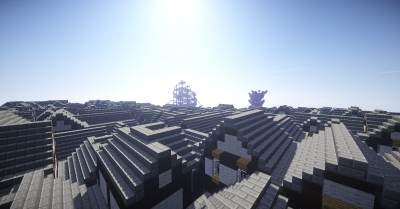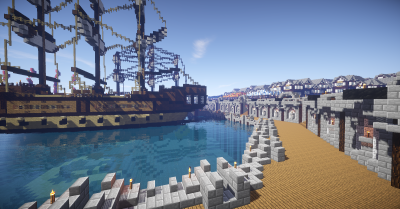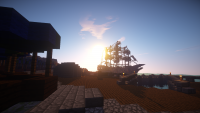Sol
Located to the west of Fulfwotz and south of the Shire United Nations, Sol is the shining jewel and capital of the new and budding Solurian Empire. Sol is currently one of the largest cities in the Shire and home to many various attractions and secrets.
Overview
History
Sol developed as a small port city on the western edge of the Shire, far from the Mainland. It quickly grew as it became known as one of the few supply points before heading further west, into the unknown. As such, Sol became known very quickly for its' large and technology-minded navy. Sol boasts one of the largest harbors in the Shire, and is well-known for the exotic and wide variety of goods and services available. The population of Sol boomed following the Unity Movement of the end of the Solurian Empire's First Age, putting it near the forefront of cities in terms of sheer population. As such, the city itself is an odd yet picturesque image of the old architecture of the Solurian Empire meeting the rapidly developing modern architecture and technology. From the harbor, the small port side houses are seen against the backdrop of developing skyscrapers and growing apartment and housing complexes which have been needed to account for the growing population. The resulting city is a sprawling megalopolis which presents the dual mindset of the Solurian people, and how they both respect the past yet look forward to the advances growing technology can offer, and the promise which lies within.
Sol was founded during the First Age of the Solurian Empire , following the evacuation from Puesta del Sol at the end of the Dawn. During the time period following the Dawn, Sol grew quickly into a trade hub as the new capital of the Solurian Empire. With the Emperor residing in and the Advisory Council based in Sol, shipping groups and trade caravans began using it as a central hub for getting goods out to the rest of the empire. As the city grew steadily, it expanded to include a nearby island as an airship port and farming area, and the space around Sol became farmland to supply the growing population. About halfway through the First Age, the small town of Alwasy was established nearby to supply glass and act as a springboard for exploration into the nearby desert.
During the Solurian Civil War of 1717, when Sol was partially occupied by mercenary groups belonging to the West Merchant Guild and the Solurian Trading Company, a complex cave system was discovered and used to transport goods and guerrilla soldiers around the city. During the end of the partial occupation, forces under command of the Solurian Army engaged mercenary groups in the headquarters of the trading groups, in what is now the Military District, and forced a retreat. While retreating, the mercenaries began burning buildings behind them to simultaneously burn evidence and block the streets. The fire quickly got out of hand, burning down nearly half the Solurian Trading Company's ships and spread to burn large portions of Sol near the citadel and the mountain. Using the previously mentioned tunnels, citizens and soldiers alike were able to evacuate the burning areas and get the fire under control before the entire city burned to the ground. Following the end of the civil war, these tunnels were solidified to support the growing city, and promptly abandoned due to their lack of use.
Currently, the city of Sol houses multiple corporate headquarters, as well as shipping centers and distribution centers for a large amount of companies based in and around the Shire. The head offices for the Solurian Trading Company and the West Merchant Guild can also be found, as they were re-established at the end of the civil war following the state requisition of company assets according to the Solurian Untiy Collective's order.
Military Structure
Sol's residential military forces, much like the forces in the empire overall, are divided into two: the Army and the Navy. The Army consists of all of Sol's ground forces and is often the branch tasked with coordinating assault efforts and the defense of the Solurian Empire's territory. The Navy, arguably one of the largest in the Solurian Empire, patrols the waters of Sol and is tasked with the defense of the Solurian Empire's holdings from the sea and air for that specific territory. The ships and airships of Sol's Navy are some of the most advanced in the current era.
The majority of the military forces in Sol are stationed around the two military bases in Sol, one at the military district surrounding the Hold, and the other at the southern end of the nearby island, near the airship port. The military district in Sol is also responsible for the training and stationing of most of the Solurian Empire's special forces groups, and they can often be seen training in the training course or on the mountain's slopes.
The territory that Sol acts as the center of, the Capital Territory, is one of the larger territories in the Solurian Empire, due mostly to the large amount of forces available for the safekeeping and defense of Sol. The forces of Sol also sometimes aid in the patrol and defense of the territory Alwasy acts as the center of, the West-Central Territory.
As for the military structure of the city of Sol itself, the peninsula and neighboring island are surrounded by large walled structures which both control what ships are able to land on the shores and provide supports and bases for cannons and other defensive structures. These cannons are usually fired on the major anniversary of the end of the Dawn and the founding of Sol, and on the summer and winter solstice celebrations due to the religious views of the Solurian Sect.
Political Climate

The royal family in the Solurian Empire had long ago given rule of the Empire to the citizens, but still remains present in pop culture and national pride. However, since Sol is the seat of power for the Solurian Empire, most of the empire's governing takes place in Sol. Sol is governed by a dual-council system, composed of a military council and a civil council, much like how the empire is governed overall. The military council consists of 10 to 15 of the high-ranking generals and admirals of Sol's army and navy, respectively. Usually these generals and admirals are 3-4 Sun according to the military ranks of the Solurian Empire. The civil council is comprised of 20 to 30 of the city's high-ranking elected officials, from city guard officers to district administrators. Each council holds roughly the same amount of power and authority. The civil council's members change due to elections and resignations and the military council's members change with deaths and promotions, thus the varied numbers present each Council Meeting.
Often, people mistake Sol's governing council for the Governing Council of the Solurian Empire, but this is not the case. Often, admirals and generals whose rank are not yet 5-Sun are placed into the council for Sol as a test of early coordination ability and authority due to the fact that Sol, and by extension the Capital territory, is the largest in the empire. Thus, if a general or admiral is capable of properly handling supervision over the Capital Territory, they are often put on the list for future Governing Council members. Since the Governing Council meeting building for the Solurian Empire is literally right next to the governing council building for Sol, high-ranking officers can often sit in for first-hand experience.
Sol is also home to multiple major Eco-friendly groups which all try to influence decisions of the Governing Council. Often, they can be seen dining with members of the Council in attempts to gain their favor, and often lobby for their views on recent expansions or movements into reservations or special ecosystems. As usual, the counterpoint to this is the large corporations based in Sol, and how they are often dining right there with the ecologically friendly representatives in an attempt to either prevent something or change the mind of the representative. Due, however, to the stubborn nature of the large majority of the governing council, most of these dinners, lunches, or breakfasts often end up as a free meal in return for little to no effect on that council member’s original decision.
Despite this, Sol remains as one of the huge centers for ecologically-minded movements, most of which focus on the destructive nature of gas or coal powered combustion systems. Pushes by these groups have greatly helped move these old engines out of steady production, and put a focus on the rapidly advancing Eco-friendly technology that is the thaumo-nuclear engine. As such, more and more people can be seen using thaumo-nuclear engines in their transport, production, and development capabilities. Even the Solurian military have begun implementing groundbreaking thaumo-nuclear mass capacitors which use surrounding carbon dioxide to rapidly create ammunition for their weapons.
Points of Interest
Sol boasts a wide variety of tourist and merchant attractions, all of which are available to the public during working hours. Sol is also home to a large amount of historical landmarks and government buildings.
- The Solurian Hold: Named the Hold by Sol's citizens, this large citadel rests upon the top of the only mountain in the region. The Hold is called as such due to the fact that under every previous siege of Sol, it was never taken. Due to the positioning of the Hold, and the tactical advantage its' position gives, the city of Sol has never been fully taken by an invading force. A complex network of hidden tunnels allows for easy transport of goods to and from the Hold in the event of a siege, allowing for practically unending time periods where the Hold can remain autonomous. Currently, THe Hold has a weekly Friday tour for history purposes, and often the tours end at the grassy outcrop which has a breathtaking view of the city of Sol down below.
However, this tour is sometimes moved to Saturday if the military council has a meeting on Friday, for obvious security concerns.

- The Port: This large port spans nearly the entire southern face of the Sol peninsula, and is where most trade is centered. The Port is split into two parts: the civilian port and the military port. The civilian port leads directly into the market areas of the southernmost Sol city districts (known as the Market Row), the warehouse district, and the island off of Sol's coast where the airship dock is. The military port, accessible through the Wolf gate or the military district, leads to the main army barracks, the shipyard, and the Hold's fortified port. While being one of the largest ports in the shire, the port of Sol is mostly known for the efficient dockworkers, and the speed with which they unload and refuel ships. This is made even more impressive due to the fact that they service a wide variety of ships, varying from sail-powered ships to thaumo-nuclear powered ships.
- The Temple: The Temple of the Stars stands in the center of Sol's main population area, and rises high above the surrounding homes and shops. It houses the altars of the Eight Gods Above, and is a central pilgrimage point for all members of the Solurian Sect. Beneath the Temple lie the ruins of the previous temples, burnt and dismantled in the third and fourth Great Wars, and the crypts of the Emperors of the First Age. Rumors have it that the catacombs also originate from this point. The Temple has long been held as a national symbol for peace and religion.
Another important aspect of the Temple of the Stars is that the roof over the main room of worship is made of a rare and unidentifiable glass which hasn't been produced since the old days of the Solurian Empire. During full moons, the moon traces a path directly over the center of the room, creating an odd effect which allows the stars in the sky to be seen so clearly it is as if you can reach out and touch them. Obviously, there is glass in the way so this is impossible, but the effect is still breathtaking and, so far, completely impossible to reproduce with modern science. Scientists also have difficulty studying the glass, as the priests of the temple do not allow testing or instrumentation which could possibly harm the glass. On normal nights, the stars appear crisp and the sky is clear of cloud cover, despite possible cloud cover outside the temple itself. Often, people can be seen entering to stargaze and enjoy the beautiful view.
- The Palace: Home of the heirs to the Emperor Eedon Neebo (first of his name) of the First Age, this ornate building remains one of the few still standing from the First Age of Sol. After the end of the Unity Movement, the remaining royal family members were offered the palace as housing, but they chose to turn it into a museum on Solurian History. It is open for guided public tours during normal working hours. The attractions do include guided tours into the Solurian Catacombs where members of the royal family, from the First Age onward, were buried after death. Without guided tours it is very possible that visitors would get lost in the vast expanse of the catacomb. It is rumored that there are secret entries into the hidden tunnels under Sol, some of which might lead across the island to The Solurian Hold.
- The Farmed Isle: Directly to the southwest of Sol is a large island which was cultured and turned into a huge food supply for the Solurian Empire and for Sol. It houses multiple large farms as well as a large water distillery at the south end which helps supply clean water for the citizens of Sol. Nearby, the water recycling center uses thaumo-nuclear power to clean, purify, and recycle water from bathrooms and showers across the city. Despite these out of place modern additions, the Farming Isle is known widely for its large and sprawling farms, which present a peaceful and serene change from the city of Sol itself. However, actually going into the farms is illegal as that is a supply of food. As such, the bridge which connects this isle to the Solurian Peninsula is heavily guarded and requires special passes. Since this checkpoint was implemented, public outcry has resulted in multiple small parks and parkways in the city, which help ease the minds of the citizens and of tourists.
- The Main Gate: The Main Gate of Sol, aptly named the Main Gate, is the largest exit from Sol to the northern wilderness areas outside of the city of Sol itself. Despite having many buildings outside the gate, this gate marks the northernmost city limit of Sol, resulting in the practically illegal sprawl of buildings outside. The Main Gate paints a powerful picture of what the Solurian Empire was capable back when the city of Sol was more of a fortified extension of the Solurian Hold rather than a major port city. It it framed by two large guard towers and the wall which extends to either side, to meet with the waterway barricades upon which the city’s main cannon defenses sit. Tourists seeing it for the first time often comment how break taking it is, and what a historical landmark it is. A recent small effort to replace it with something more modern and durable was met with a huge public outcry, seeing as it is one of the few major pieces of history left untouched in the Solurian Empire, seeing as the main figurehead was taken directly from Puesta del Sol itself. As a result, the effort was pretty heavily crushed. Thus, this gateway is likely to remain for the foreseeable future. The gateway does, in fact, function as a gateway And checkpoint.
Geographic Location
 |
... | Keikei Bay | Nunya | 
|
| ... | Castle Argh | |||
| ||||
| Alwasy | Vertiment | Marzipan |
Build History

The build was started by Master_Chief sometime in mid-February, 2015, when work on the dock area started. After completing nearly the entire dock by hand, a long break was taken. Building resumed in May, 2015, where Master_Chief began work on the districts, citadel, and various other parts of Sol. Work continues to this day.

